Moderate overlap front: original test
Rating applies to 2004-12 models
Tested vehicle: 2004 Mitsubishi Galant ES 4-door
The Mitsubishi Galant was redesigned for the 2004 model year.
| Overall evaluation | |
|---|---|
| Structure and safety cage | |
| Driver injury measures | |
| Head/neck | |
| Chest | |
| Leg/foot, left | |
| Leg/foot, right | |
| Driver restraints and dummy kinematics |
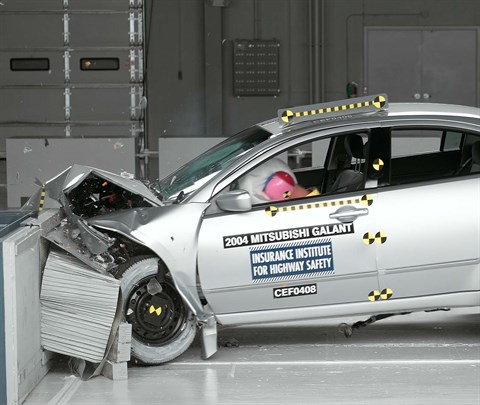
Action shot taken during the frontal offset crash test.
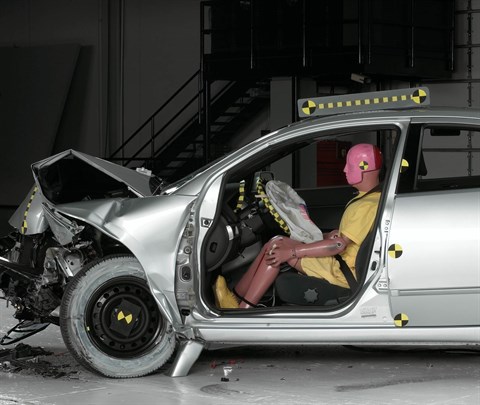
The dummy's position in relation to the steering wheel and instrument panel after the crash test indicates that the driver's survival space was maintained well.
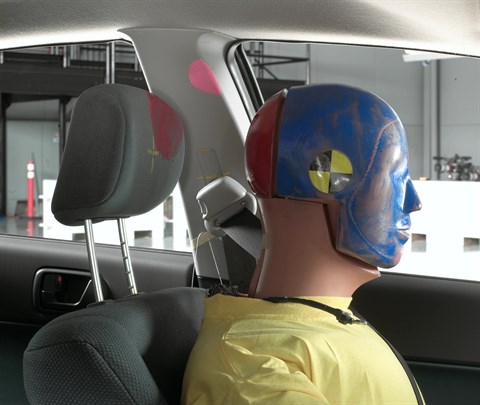
Smeared greasepaint indicates where the dummy's head hit the B-pillar and head restraint during rebound. Head accelerations from these hits were low.
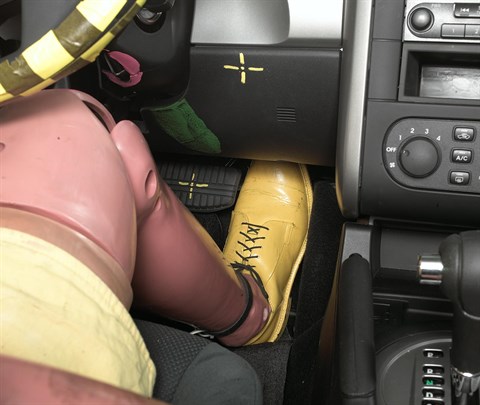
Forces on the lower right leg were high enough to indicate the possibility of injuries.
Measures of occupant compartment intrusion on driver side
| Test ID | CEF0408 |
|---|---|
| Footwell intrusion | |
| Footrest (cm) | 11 |
| Left (cm) | 20 |
| Center (cm) | 18 |
| Right (cm) | 13 |
| Brake pedal (cm) | 13 |
| Instrument panel rearward movement | |
| Left (cm) | 1 |
| Right (cm) | 1 |
| Steering column movement | |
| Upward (cm) | 2 |
| Rearward (cm) | 0 |
| A-pillar rearward movement (cm) | 1 |
Driver injury measures
| Test ID | CEF0408 |
|---|---|
| Head | |
| HIC-15 | 308 |
| Peak gs at hard contact | 25 |
| Neck | |
| Tension (kN) | 1.6 |
| Extension bending moment (Nm) | 20 |
| Maximum Nij | 0.36 |
| Chest maximum compression (mm) | 32 |
| Legs | |
| Femur force - left (kN) | 0.2 |
| Femur force - right (kN) | 2.8 |
| Knee displacement - left (mm) | 0 |
| Knee displacement - right (mm) | 0 |
| Maximum tibia index - left | 0.47 |
| Maximum tibia index - right | 1.09 |
| Tibia axial force - left (kN) | 3.0 |
| Tibia axial force - right (kN) | 4.9 |
| Foot acceleration (g) | |
| Left | 77 |
| Right | 93 |
Side: original test
Rating applies to 2004 models built after October 2003
Tested vehicle: 2004 Mitsubishi Galant ES 4-door without optional side airbags
The Mitsubishi Galant was redesigned for the 2004 model year. All 2004 and later Galant models manufactured after October 2003 include a rear door structural upgrade to improve occupant protection in side-impact crashes. (Information about when a specific vehicle was manufactured is on the certification label typically affixed to the car on the driver door or adjacent B-pillar.)
When side airbags are optional, as in this vehicle, the Institute conducts the test without this option. If a manufacturer offering optional side airbags requests the Institute to conduct an additional test of a vehicle with this option and agrees to reimburse the cost of the vehicle, a second test is conducted. Mitsubishi did not request such a test.
However, Mitsubishi made side airbags for front seat occupants standard in the 2005 model year and the Institute tested the 2005 model. The 2004 and 2005 models are rated separately, except that the structural ratings and rear passenger injury and head protection ratings for both vehicles are based on both tests.
| Overall evaluation | |
|---|---|
| Structure and safety cage | |
| Driver injury measures | |
| Head/neck | |
| Torso | |
| Pelvis/leg | |
| Driver head protection The dummy's head was hit by the intruding barrier, producing high head injury measures. |
|
| Rear passenger injury measures | |
| Head/neck | |
| Torso | |
| Pelvis/leg | |
| Rear passenger head protection The dummy's head was hit by the window frame and window sill of the rear door. These hits did not produce high head injury measures, but the head protection is inadequate. |
|

View of the vehicle and barrier just after the crash test.
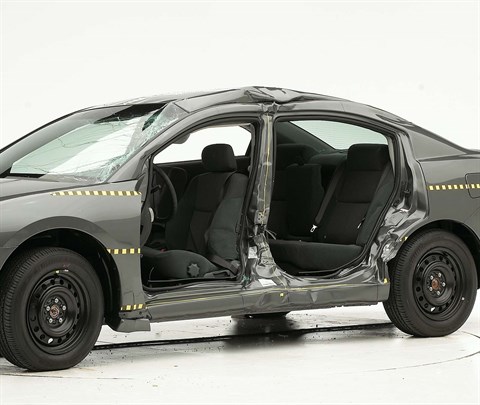
View of the vehicle after the crash with doors removed, showing damage to the occupant compartment.
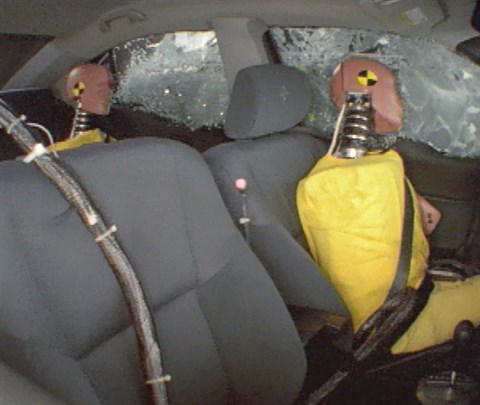
Action shot taken during the side impact crash test showing the driver dummy's head being hit by the intruding barrier.
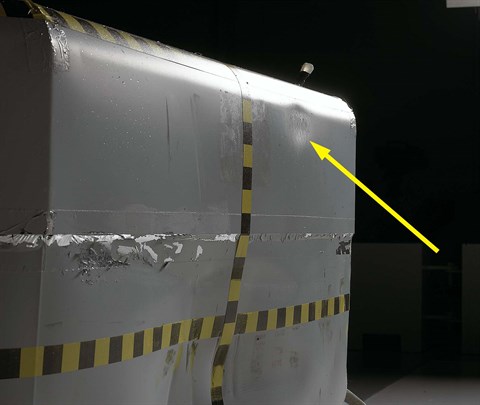
A noticeable dent indicates where the driver dummy's head hit the barrier.
Measures of occupant compartment intrusion on driver side
| Test ID | CES0402 | CES0418 |
|---|---|---|
| B-pillar to longitudinal centerline of driver's seat (cm) | -14.0 | -11.0 |
| Negative numbers indicate the amount by which the crush stopped short of the seat centerline. | ||
Driver injury measures
| Test ID | CES0402 |
|---|---|
| Head HIC-15 | 890 |
| Neck | |
| Tension (kN) | 2.0 |
| Compression (kN) | 0.4 |
| Shoulder | |
| Lateral deflection (mm) | 59 |
| Lateral force (kN) | 6.0 |
| Torso | |
| Maximum deflection (mm) | 48 |
| Average deflection (mm) | 35 |
| Maximum deflection rate (m/s) | 7.00 |
| Maximum viscous criterion (m/s) | 1.39 |
| Pelvis | |
| Iliac force (kN) | 1.6 |
| Acetabulum force (kN) | 2.6 |
| Combined force (kN) | 4.0 |
| Left femur | |
| L-M force (kN) | 0.4 |
| L-M moment (Nm) | 158 |
| A-P moment (Nm) | 65 |
Passenger injury measures
| Test ID | CES0402 | CES0418 |
|---|---|---|
| Head HIC-15 | 332 | 356 |
| Neck | ||
| Tension (kN) | 1.4 | 1.4 |
| Compression (kN) | 0.2 | 0.1 |
| Shoulder | ||
| Lateral deflection (mm) | 34 | 41 |
| Lateral force (kN) | 1.7 | 1.7 |
| Torso | ||
| Maximum deflection (mm) | 34 | 41 |
| Average deflection (mm) | 23 | 31 |
| Maximum deflection rate (m/s) | 3.54 | 3.38 |
| Maximum viscous criterion (m/s) | 0.59 | 0.67 |
| Pelvis | ||
| Iliac force (kN) | 0.7 | 0.7 |
| Acetabulum force (kN) | 1.2 | 0.9 |
| Combined force (kN) | 1.5 | 1.5 |
| Left femur | ||
| L-M force (kN) | 0.3 | 0.4 |
| L-M moment (Nm) | 172 | 142 |
| A-P moment (Nm) | -38 | -37 |
Roof strength
Rating applies to 2004-12 models
Tested vehicle: 2009 Mitsubishi Galant ES 4-door
| Overall evaluation | |
|---|---|
| Curb weight | 3,438 lbs |
| Peak force | 13,107 lbs |
| Strength-to-weight ratio | 3.81 |
Head restraints & seats
Seat type: Cloth seats
| Overall evaluation | |
|---|---|
| Dynamic rating | |
| Seat/head restraint geometry |
| Seat type | Cloth seats |
|---|---|
| Geometry | |
| Backset (mm) | 90 |
| Distance below top of head (mm) | 75 |
| Seat design parameters | |
| Pass/fail | Fail |
| Max T1 acceleration (g) | 13.4 |
| Head contact time (ms) | 100 |
| Force rating | 3 |
| Neck forces | |
| Max neck shear force (N) | 280 |
| Max neck tension (N) | 887 |
Seat type: Leather seats
| Overall evaluation | |
|---|---|
| Dynamic rating | |
| Seat/head restraint geometry |
| Seat type | Leather seats |
|---|---|
| Geometry | |
| Backset (mm) | 70 |
| Distance below top of head (mm) | 85 |
| Seat design parameters | |
| Pass/fail | Fail |
| Max T1 acceleration (g) | 0.0 |
| Head contact time (ms) | |
| Force rating | 0 |
| Neck forces | |
| Max neck shear force (N) | |
| Max neck tension (N) | |
How the head restraint & seat test is conducted
Currently, IIHS tests apply only to front seats.
